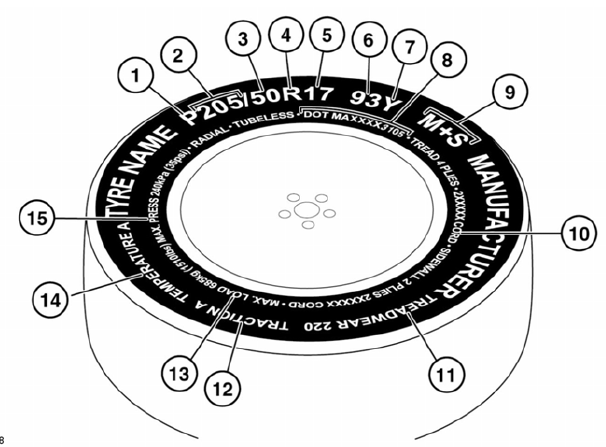Land Rover Discovery: Tyre markings

- P indicates that the tyre is for passenger vehicle use. This index is not always shown.
- The width of the tyre from sidewall edge to sidewall edge, in millimetres.
- The aspect ratio, also known as the profile, gives the sidewall height as a percentage of the tread width. So, if the tread width is 205 mm and the aspect ratio is 50, the sidewall height will be 102 mm.
- R indicates that the tyre is of Radial ply construction.
- The diameter of the wheel rim, given in inches.
- The load index for the tyre. This index is not always shown.
The load index and speed rating on all replacement tyres must be, at least, the same specification as the manufacturer's original equipment supplied with the vehicle (except for approved winter tyres). If in doubt, consult a Retailer/Authorised Repairer.
- The speed rating denotes the maximum speed at which the tyre may be used for extended periods.
- Tyre manufacturing standard
information, which can be used for tyre
recalls and other checking processes.
Most of this information relates to the manufacturer, place of manufacture, etc. The last four numbers are the date of manufacture. For example, if the number was 3106, the tyre was made in the 31st week of 2006.
- M+S or M/S indicates that the tyre has been designed with some capability for mud and snow.
- The number of plies in both the tread area and the sidewall area, indicates how many layers of rubber-coated material make up the structure of the tyre. Information is also provided on the type of materials used.
- Wear rate indicator: A tyre rated at 400, for example, will last twice as long as a tyre rated at 200.
- The traction rating grades a tyre's
performance when stopping on a wet
road surface. The higher the grade,
the better the braking performance.
The grades, from highest to lowest are; AA, A, B, and C.
The traction grade assigned to this tyre is based on straight-ahead braking traction tests and does not include acceleration, cornering, hydroplaning, or peak traction characteristics.
- The maximum load which can be carried by the tyre.
- Heat resistance grading: The tyres resistance to heat is grade A, B, or C, with A indicating the greatest resistance to heat. This grading is provided for a correctly inflated tyre, which is being used within its speed and loading limits.
- The maximum inflation pressure for the tyre. This pressure should not be used for normal driving.
SPEED RATING
.jpg)
TYRE CARE
- Do not drive the vehicle if a tyre is damaged, excessively worn, or incorrectly inflated.
- Avoid contaminating the tyres with vehicle fluids, as they may cause damage to the tyre.
- Avoid spinning the wheels. The forces released can damage the structure of the tyre, and cause it to fail.
- If wheel spin is unavoidable due to a loss of traction (in deep snow, for example), do not exceed the 50 km/h (30 mph) point on the speedometer.
- Do not exceed the maximum pressure stated on the sidewall of the tyre.
Note: Tyre condition should be checked after the vehicle has been used off-road.
As soon as the vehicle returns to a normal, hard, road surface, stop and check for damage to the tyres.
All of the vehicle's tyres (including the spare) should be checked regularly for damage, wear, and distortion. If you are in any doubt about the condition of a tyre, have it checked immediately by a tyre repair centre or a Retailer/Authorised Repairer.

